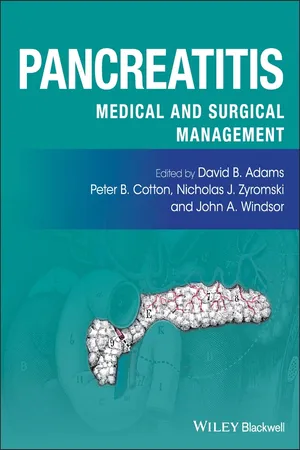
Pancreatitis
Medical and Surgical Management
- English
- ePUB (mobile friendly)
- Available on iOS & Android
Pancreatitis
Medical and Surgical Management
About this book
Pancreatitis: medical and surgical management provides gastroenterologists and GI surgeons, both fully qualified and in training, with a focused, evidence-based approach to the most exciting developments in the diagnosis and clinical management of pancreatitis.
Focusing mainly on the rapidly changing and innovative medical and surgical strategies to manage the disease, new surgical procedures such as endoscopic biliary intervention and minimally invasive necrosectomy to exciting new medical therapies like Antiprotease, Lexipafant, probiotics and enzyme treatment are all discussed.
Full colour throughout, with over 250 colour illustrations and with reference to the latest clinical guidelines from the AGA, ACG and UEGW at all times, it is an essential consultation tool for all those managing patients with this increasingly common condition.
Frequently asked questions
- Essential is ideal for learners and professionals who enjoy exploring a wide range of subjects. Access the Essential Library with 800,000+ trusted titles and best-sellers across business, personal growth, and the humanities. Includes unlimited reading time and Standard Read Aloud voice.
- Complete: Perfect for advanced learners and researchers needing full, unrestricted access. Unlock 1.4M+ books across hundreds of subjects, including academic and specialized titles. The Complete Plan also includes advanced features like Premium Read Aloud and Research Assistant.
Please note we cannot support devices running on iOS 13 and Android 7 or earlier. Learn more about using the app.
Information
Chapter 1
Epidemiology and genetics of pancreatitis
Definition
Burden of disease
Clinical features
Diagnosis
Animal models of early CP
Genetic risk factors for CP
Table of contents
- Cover
- Title Page
- Copyright
- Table of Contents
- List of contributors
- Chapter 1: Epidemiology and genetics of pancreatitis
- Chapter 2: Part A: Pathobiology of the acinar cell in acute pancreatitis
- Chapter 2: Part B: Locoregional pathophysiology in acute pancreatitis: pancreas and intestine
- Chapter 2: Part C: Pathophysiology of systemic inflammatory response syndrome and multiorgan dysfunction syndrome in acute pancreatitis
- Chapter 3: Diagnosis, prediction, and classification
- Chapter 4: Medical treatment
- Chapter 5: Nutritional treatment in acute pancreatitis
- Chapter 6: Gallstone pancreatitis: diagnosis and treatment
- Chapter 7: Treatment of local complications
- Chapter 8: Treatment of systemic complications and organ failure
- Chapter 9: Specific treatment for acute pancreatitis
- Chapter 10: Sequelae of acute pancreatitis
- Chapter 11: History of chronic pancreatitis
- Chapter 12: Part A: Epidemiology and pathophysiology: epidemiology and risk factors
- Chapter 12: Part B: Epidemiology and pathophysiology: genetic insights into pathogenesis
- Chapter 12: Part C: Pancreatic stellate cells: what do they tell us about chronic pancreatitis?
- Chapter 12: Part D: Autoimmune pancreatitis: an update
- Chapter 12: Part E: Etiology and pathophysiology: tropical pancreatitis
- Chapter 12: Part F: Mechanisms and pathways of pain in chronic pancreatitis
- Chapter 13: Part A: Imaging of chronic pancreatitis
- Chapter 13: Part B: Endoscopic ultrasonography in chronic pancreatitis
- Chapter 14: Part A: Pancreatic enzyme replacement therapy (PERT)
- Chapter 14: Part B: Nutritional treatment: antioxidant treatment
- Chapter 14: Part C: Pancreatogenic diabetes: etiology, implications, and management
- Chapter 14: Part D: Nutrition without a pancreas: how does the gut do it?
- Chapter 15: Part A: Endoscopic management of chronic pancreatitis
- Chapter 15: Part B: Shocking and fragmenting pancreatic ductal stones
- Chapter 15: Part C: Endoscopic management: celiac plexus blockade
- Chapter 16: Part A: A brief history of modern surgery for chronic pancreatitis
- Chapter 16: Part B: Surgery for chronic pancreatitis: indications and timing of surgery
- Chapter 16: Part C: Chronic pancreatitis: surgical strategy in complicated diseases
- Chapter 16: Part D: Surgery for chronic pancreatitis: pancreatic duct drainage procedures
- Chapter 16: Part E: Surgical management: resection and drainage procedures: Chronic pancreatitis – hybrid procedures
- Chapter 16: Part F: The role of pancreatoduodenectomy in the management of chronic pancreatitis
- Chapter 17: Part A: Total pancreatectomy and islet cell autotransplantation: patient selection
- Chapter 17: Part B: Total pancreatectomy and islet cell autotransplantation: the science of islet cell preservation, from pancreas to liver
- Chapter 17: Part C: Total pancreatectomy and islet cell autotransplantation: long-term assessment of graft function
- Index
- End User License Agreement